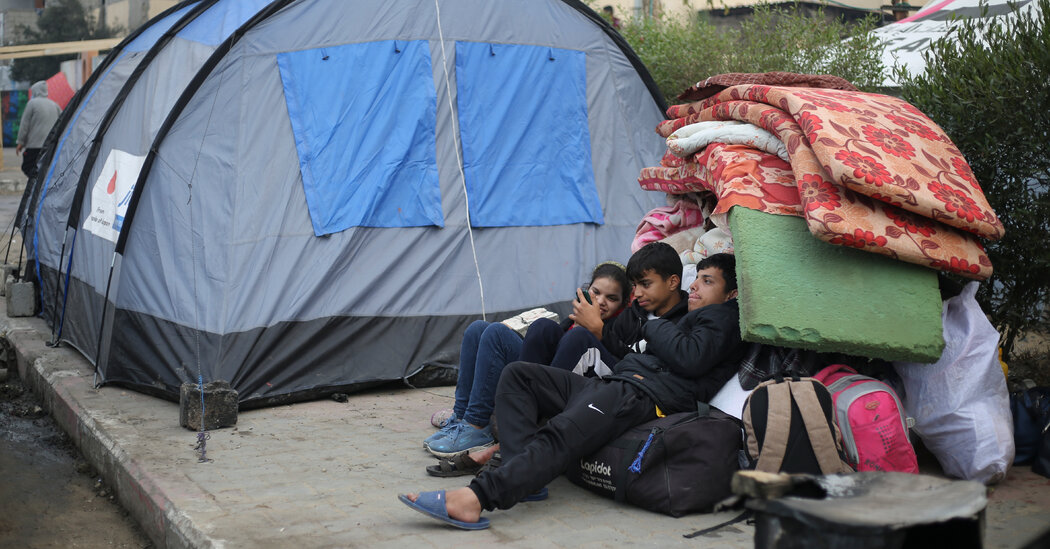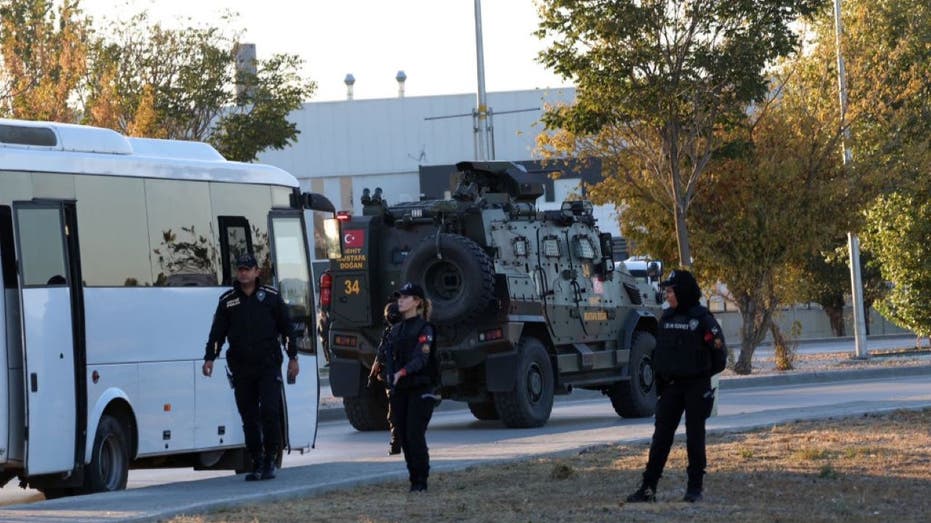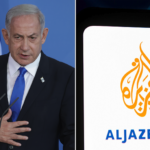The Israeli military acknowledged for the first time on Thursday that it had carried out two airstrikes in the central Gaza Strip on Dec. 24, which according to health officials in the enclave killed dozens of civilians.
It was a rare admission of fault regarding a specific event during a war that has so far claimed more than 20,000 lives in the enclave, the majority of them women and children, according to the Gazan health ministry. The Israeli military said in a statement that it “regrets the harm to uninvolved individuals, and is working to draw lessons from the incident.”
Referring to strikes in Al Maghazi, a neighborhood in central Gaza, the military said in the statement that as part of its operations in the area, Israeli fighter jets had struck two targets adjacent to where “Hamas operatives” were located.
Despite steps that were taken to mitigate harm to civilians in the area, the military said, “A preliminary investigation revealed that additional buildings near the targets were also hit during the strikes, which likely caused unintended harm to additional uninvolved civilians.”
An unidentified military official told Kan News, Israel’s public broadcaster, on Thursday that an improper choice of weaponry was to blame for the extensive damage and high civilian death toll, adding that the type of munition used did not match the nature of the attack.
A military fact-finding committee will further investigate the event, the military said in its statement.
Khalil Deqran, the spokesman for a hospital in nearby Deir al Balah, told the broadcast network Al Araby on the night of the attack that the hospital had received more than 70 bodies from strikes in Al Maghazi and Al Bureij, another neighborhood in the central Gaza Strip, and that the dead included many women, children and older people.
Al Maghazi was created in 1949 as one of eight camps in Gaza established to house Palestinians who fled or were expelled during the wars surrounding Israel’s creation. The camps have generally been built up over time to become tightly packed neighborhoods.
Al Maghazi is densely packed, with a prewar population of 33,255 people in 0.6 square kilometers, or 0.2 square miles, according to UNRWA, the U.N. agency that aids Palestinian refugees and their descendants, and operates the camps.
Iyad Abuheweila contributed reporting.
A looming Supreme Court decision on Prime Minister Benjamin Netanyahu’s divisive plan to overhaul Israel’s courts returned to major public attention on Thursday, after an Israeli television channel reported that a leaked draft of the court’s ruling showed a narrow majority of the court intended to block a key part of the overhaul.
The development revived Israel’s confrontation with the country’s deep fissures over the overhaul plan and threatened to disrupt Mr. Netanyahu’s fragile wartime government. The overhaul plan had prompted huge, monthslong protests that, before the war, were seen as one of the gravest domestic political crises Israel had faced in the 75 years since the nation’s founding.
The New York Times has not obtained a copy of the leaked decision, and the Israeli television outlet, Channel 12, did not publish a full version of the document. A spokeswoman for Israel’s courts said on Thursday that “the writing of the ruling is not yet complete.” The court’s decision is expected in mid-January.
The ruling has the potential to throw Israel’s unity government, formed after the Oct. 7 Hamas-led terrorist attacks, into disarray as the country wages war in Gaza and faces international pressure over the scope of its military campaign.
The Channel 12 report, on Wednesday night, said that eight of the court’s 15 judges were set to overturn a law passed in July that stripped the Israeli Supreme Court of the power to overturn government actions and appointments it deems “unreasonable.”
Mr. Netanyahu’s right-wing governing coalition had pushed the law through the Israeli Parliament, saying the law was needed to remove the court’s ability to overrule the will of the majority.
Before the Hamas invasion, two members of Israel’s new war cabinet — one of Mr. Netanyahu’s longtime rivals, Benny Gantz, and Defense Minister Yoav Gallant — had criticized the government’s pursuit of the overhaul. Mr. Netanyahu tried to fire Mr. Gallant, the defense minister, after criticized the pace of the plan, only to reverse his decision amid widespread outrage.
Should the court rule against Mr. Netanyahu, it could set off a constitutional crisis within Israel if his allies try to defy it. Regardless of the outcome, the case is considered one of the most consequential in Israel’s history. Not only could it determine the extent to which politicians are subject to judicial oversight, but it has also led to the spectacle of a court weighing in on an issue that directly affects its own powers.
The law was part of Mr. Netanyahu’s wider plan to weaken the country’s judiciary, which led to the months of huge street protests. Opponents, including Israel’s chief justice and attorney general, said the plan — if fully carried out — would deal a fatal blow to the country’s separation of powers.
But the dispute faded into the background after the Hamas attacks on Oct. 7, in which roughly 1,200 people were killed and more than 240 were taken hostage to Gaza, according to the Israeli authorities.
Four days after the attack, Mr. Netanyahu formed a wartime government with opponents including Mr. Gantz, the leader of the opposition National Unity alliance, who opposed the judicial overhaul.
The crisis over the judicial changes was a proxy for deeper rifts over Israel’s future. Secular and liberal Israelis view the Supreme Court as a bulwark in a country that is becoming more conservative and religious.
A report that Israel’s Supreme Court might strike down part of Prime Minister Benjamin Netanyahu’s judicial overhaul — passed by the Israeli Parliament in July — has raised the specter of renewed discord in the country.
Before Hamas’s attack on Oct. 7, monthslong protests against the overhaul, which among other proposals curbed the courts’ ability to strike down government decisions and appointments on the basis that they were “unreasonable,” had become a part of daily life in Israel.
Supporters of the new law deemed it necessary to rein in activist judges. But critics of the overhaul, including the country’s chief justice and attorney general, argued that the reforms would endanger democracy in Israel.
A rare leaked draft, reported by Israel’s Channel 12 broadcaster on Wednesday night, indicating that the court was set to strike down the law in a landmark decision sparked criticism from Mr. Netanyahu’s hard-line coalition allies on Thursday. Some cited the war in Gaza as yet another reason for the Supreme Court to stay out of the matter.
The top court “must not create a deep rift in the country, even as we all plead for unity,” Yariv Levin, the justice minister widely seen as the overhaul’s architect, said in a statement on Thursday.
But with two Supreme Court justices presiding over the case having reached retirement age in October, the court is bound by law to publish its decision by mid-January, said Amir Fuchs, a constitutional law expert at the Jerusalem-based Israel Democracy Institute, a think tank.
“Those who are criticizing them for rendering this judgment in the middle of a war are playing dumb,” said Mr. Fuchs. “They have to publish it in the next two weeks. That’s the deadline under the law.”
Since the Oct. 7 attack, many Israelis have called on one another to set aside the deep internal rifts prompted by the overhaul until the end of the military campaign against Hamas in Gaza. Some of Mr. Netanyahu’s opponents, including the National Unity alliance leader Benny Gantz, joined the prime minister in an emergency wartime unity government.
Mr. Gantz’s partnership with Mr. Netanyahu and his allies has been fragile from the start, political analysts said, and might not survive another crisis related to the judicial overhaul. Mr. Netanyahu has refused to say whether he would respect a Supreme Court decision striking down the law.
Shalom Yerushalmi, a political commentator for Zman Yisrael, an Israeli news site, said should Mr. Netanyahu ultimately decide to respect the ruling, it would likely anger some of his far-right coalition partners. Defying the justices’ decision, however, could splinter the wartime unity government, he said.
Should Mr. Netanyahu “decide not to respect the court’s decision, it’s clear to everyone that Gantz can’t stay in the government,” said Mr. Yerushalmi.
The leak could serve Mr. Netanyahu’s interests, he added, by increasing public pressure on the Supreme Court justices not to strike down the law in wartime.
In July, Israel’s government passed a law stripping the Supreme Court of the right to use the subjective concept of “reasonableness” to countermand decisions by lawmakers and ministers. It was the first step in a plan by Prime Minister Benjamin Netanyahu’s government — at the time the most right-wing and religiously conservative in Israeli history — to limit the influence of the country’s most powerful court.
Reasonableness is a legal standard used by many judicial systems, including in Australia, Britain and Canada. A decision is deemed unreasonable if a court rules that it was made without considering all relevant factors or without giving relevant weight to each factor, or by giving irrelevant factors too much weight.
Mr. Netanyahu’s political allies say that reasonableness is too vague a concept, that it was never codified in Israeli law, and that judges apply it in subjective ways. The Supreme Court angered the government this year when some of its judges used the tool to bar Aryeh Deri, a veteran ultra-Orthodox politician, from serving in Mr. Netanyahu’s cabinet. Judges said it was unreasonable to appoint Mr. Deri because he had recently been convicted of tax fraud.
The bill was an amendment to a Basic Law — one of the body of laws that have quasi-constitutional status in Israel — and Israeli analysts say that the Supreme Court has so far never intervened in, or struck down, a Basic Law. The high court has discussed such laws in the past but never ruled on them.
In September, the justices heard an appeal filed by groups opposing the law. Over 13 hours of arguments, the judges’ questions and statements indicated that several members of the court had concerns about the law.
“The duty to act reasonably also applies to the government and its ministers,” the chief justice, Esther Hayut, said in one exchange. But if the court were barred from using the reasonableness standard, Justice Hayut added, “Who ensures that they do indeed act reasonably?”
The divisions over the law are part of a wider ideological and cultural standoff between Mr. Netanyahu’s political allies and their supporters, who want to make Israel into a more religious and nationalist state, and their opponents, who hold a more secular and pluralist vision of the country.
Mr. Netanyahu’s right-wing coalition partners have argued that the Supreme Court had too much leeway to intervene in political decisions; that it undermined Israeli democracy by giving unelected judges too much power over elected lawmakers; and too often acted against right-wing interests.
Opponents fear that the law will make the court much less able to prevent government overreach. They say that the government could find it easier to end the prosecution of Mr. Netanyahu, who is on trial on corruption charges, and to restrict civil liberties or undermine secular aspects of Israeli society.
Judih Weinstein Haggai, a 70-year-old who was believed to have been taken hostage by Hamas, was actually killed during the Oct. 7 attacks on Israel, her family and Kibbutz Nir Oz said in statements on Thursday.
Ms. Haggai’s husband, Gadi Haggai, had also been listed as a hostage but the Hostages and Missing Persons Families Forum announced last week that he, too, was killed in the attacks.
The forum said the couple were shot while on their morning walk through the fields of the kibbutz, and that Ms. Haggai had managed to inform friends that they had been injured, her husband critically so.
Ms. Haggai was, in fact, fatally wounded, and her death has now been confirmed, Kibbutz Nir Oz said on Thursday. Its statement did not specify how it learned that she had died in the attack.
The couple’s bodies are being held by Hamas, according to the kibbutz, their family and the Hostages and Missing Persons Families Forum. The groups said the couple were citizens of both Israel and the United States, and that Ms. Haggai also had Canadian citizenship.
President Biden said he and Jill Biden, the first lady, were holding the couple’s “four children, seven grandchildren and other loved ones close to our hearts.”
“I will never forget what their daughter, and the family members of other Americans held hostage in Gaza, have shared with me,” he said in a statement. “They have been living through hell for weeks.”
Ms. Haggai would be remembered “for the creative life she built with her husband,” her family said, adding that “their murders are a reminder for leaders everywhere to bring the hostages home now before it is too late.”
When Samir Hassan and his surviving family members fled their home in the town of Mughraqa in the central Gaza Strip weeks ago, they did so under intense Israeli airstrikes, which killed a number of family members, including an uncle, and severely injured his brother.
They settled in a tent in the nearby Nuseirat area, where tens of thousands of Palestinians forced by Israel’s air and ground offensive had also fled and were finding what shelter they could in overcrowded schools, ramshackle tents or even out in the streets.
Now Mr. Hassan’s family has been warned they must move again.
The Israeli military this week ordered more than 150,000 people to leave parts of central Gaza. “The area you are in is considered an area of deadly fighting,” warned leaflets that were dropped over homes, shelters and encampments.
“God willing this will be the last time we are displaced,” said Mr. Hassan, 22, a taxi driver. The family lost everything the first time it fled, he said.
Israel’s war on Hamas has forced many of Gaza’s 2.3 million Palestinians to repeatedly flee for their lives as airstrikes bombard their towns and cities and Israeli forces advance their ground invasion.
The area now under threat, roughly nine square kilometers, has six shelters housing about 61,000 displaced people, mostly from northern Gaza, according to the United Nations. That is in addition to the 90,000 original residents of the area.
In its latest evacuation orders, Israel instructed people to move immediately to shelters that, the U.N. says, can barely hold the several hundred thousand people already there.
Some 1.9 million people in Gaza, or nearly 85 percent of the population, are estimated to be displaced, according to the U.N. relief agency for Palestinians.
Palestinians seeking help after an Israeli strike in central Gaza on Thursday.Credit…Mohammed Asad/Associated Press
“Forced to move again,” the agency said on Thursday. “Evacuation order by Israeli authorities of middle Gaza causes ongoing forced displacement. Over 150,000 people — young children, women carrying babies, people with disabilities & the elderly — have nowhere to go.”
The only remaining hope for Gazans, the agency said, is a cease-fire.
Israel’s evacuation orders — which the United Nations has said risk forced displacement, which is a war crime — have at times been contradictory and confusing. And even when Gazans make the wrenching decision to uproot their families yet again, they are forced to make impossible choices, with no safe places to go.
The Israeli bombardment and the siege of Gaza have decimated large parts of the Palestinian enclave and its infrastructure, leaving millions hungry and exposed to the elements and creating a public health disaster in the making.
Israel has said it is addressing the humanitarian concerns, including those voiced by the United States. A military spokesman, Lt. Col. Avichay Adraee, said on social media that in an effort to help Gazans understand the evacuation directives, they had published maps divided into grids “in order to preserve your security and safety.”
But Israel has routinely used 2,000-pound bombs — one of the biggest and most destructive supplied by the United States — in densely populated areas in southern Gaza where civilians were told to move for safety, according to an analysis of the visual evidence by The New York Times.
At the Aqsa Hospital in Deir al-Balah, a mother of five said that she and 20 members of her extended family had arrived there the previous day. It is the fourth time the family, including a 10-month-old baby, have been forced to flee since the war began.
“They threatened the entire block around us, even the new camp, even the market street — all of it they threatened,” she said. “They dropped leaflets ordering us to leave within three days. So we had to come here.”
Living in a thin tent in the winter cold has made all her children sick, she said. Now they are living on the cold pavement outside the hospital.
“We don’t have mattresses,” she said. “We only have blankets. Either we cover ourselves with them, or we sleep on them.”
As Israel pounded targets in the Gaza Strip on Wednesday, a member of the country’s war cabinet threatened action on a second front, along the northern border with Lebanon, where the Iranian-backed militia Hezbollah has fired rocket barrages into Israel.
“The stopwatch for a diplomatic solution is running out,” Benny Gantz, a member of Israel’s war cabinet and former defense minister, told reporters Wednesday. “If the world and the Lebanese government don’t act in order to prevent the firing on Israel’s northern residents, and to distance Hezbollah from the border, the I.D.F. will do it,” he said, referring to Israel’s military.
“The next stages in fighting will also be deep, forceful, and surprising,” added Mr. Gantz. “The campaign will continue and expand, according to necessity, to more foci or fronts.”
The threat of a wider war has preoccupied the United States and its allies since the start of the conflict in Gaza, and has only grown as three Iranian-backed groups — Hamas, Hezbollah and Houthis in Yemen — have launched attacks toward Israel as well as on commercial ships in the Red Sea.
The concern prompted the United States to dispatch two aircraft carriers to the eastern Mediterranean after the Oct. 7 Hamas-led attacks on Israel that started the war in Gaza.
The Israeli military said Wednesday that its northern command, along the border with Lebanon, was in a “state of very high readiness.” The military’s chief of staff, Lt. Gen. Herzi Halevi, said, “We need to be prepared to strike if required.”
Tensions rose even higher this week after Iran accused Israel of killing Brig. Gen. Sayyed Razi Mousavi, a senior adviser to Iran’s Islamic Revolutionary Guards Corps, in a missile strike in Syria.
Iranian mourners around a truck carrying the flag-draped coffin of Brig. Gen. Sayyed Razi Mousavi in Tehran on Thursday. Iran has accused Israel of assassinating him and vowed revenge. Credit…Arash Khamooshi for The New York Times
In a reflection of the general’s importance, state television showed Iran’s supreme leader, Ayatollah Ali Khamenei, praying before his coffin on Thursday, The Associated Press reported, and hundreds of mourners formed his funeral cortege from a central square in Tehran to a shrine north of the city for the burial. The head of the Revolutionary Guards, Gen. Hossein Salami, vowed vengeance, calling for “the removal of Israel from the face of existence,” according to The A.P.
But hints of division among Israel’s adversaries emerged on Wednesday, when Mr. Sharif claimed that Hamas’s Oct. 7 attack was prompted not by longstanding grievances with Israel, but by the 2020 killing of Gen. Qassem Soleimani, the leader of Iran’s elite Quds Force, in a U.S. drone strike in Iraq. Hamas promptly rejected the suggestion.
The U.S. government moved on Thursday to dry up the flow of Iranian funds to the Houthi militia in Yemen, which has been sowing chaos on the Red Sea since the war in Gaza began.
The Treasury Department said it had imposed financial sanctions on one person and three organizations that had “facilitated the transfer of millions of dollars” to the Houthis. Iran has long cultivated an alliance with the Houthis, a once-scrappy tribal group that took over much of northern Yemen in the last decade, bringing them into an Iran-backed network of regional militias that Tehran calls “the Axis of Resistance.”
The Houthis have seized on the conflict in Gaza to expand their footprint, shooting missiles at Israel and harrying ships transiting the Red Sea. The maritime attacks have threatened the global economy, prompting some major shippers and oil companies to reroute cargo away from the Suez Canal.
“The Houthis’ continued attacks against international shipping in the Red Sea and the Gulf of Aden have sharply curtailed the free flow of commerce through the region and represent a clear violation of international law,” the Treasury Department said in announcing the sanctions.
The department said it was imposing sanctions on the head of the Currency Exchangers Association in Yemen’s capital, Sana, and on three exchange houses in Yemen and Turkey. The exchanges were described as having helped transfer money to the Houthis at the direction of an associate of Iran’s Islamic Revolutionary Guard, Sa’id al-Jamal.
“The Sa’id al-Jamal network relies on a web of exchange houses based throughout the Middle East to facilitate the movement of Iranian funds to Houthi-aligned financial firms in Yemen,” the department said.
When sanctions are imposed on individuals or organizations, their U.S.-based assets are blocked and must be reported to the government, and other people and financial institutions that do business with them may also face enforcement action.
The Palestine Red Crescent Society said Israeli forces struck near a hospital it operates in southern Gaza on Thursday, killing several people, a day after another deadly Israeli attack in front of the same medical facility.
Over the two days, more than 40 people were killed in the strikes near the facility, Al-Amal Hospital in Khan Younis, the aid group said. The Israeli military has announced an expanded offensive in Khan Younis, the biggest city in southern Gaza.
Most of those killed on Wednesday were displaced people who were seeking shelter in and around the hospital, said Nebal Farsakh, a spokeswoman for the Palestine Red Crescent Society. Some 14,000 displaced Palestinians were sheltering at Al-Amal, according to the World Health Organization, which sent a team to visit the hospital on Tuesday.
Medical centers have become places of refuge for many of the nearly two million Palestinians who have been forced to flee for safety again and again because of Israel’s aerial bombardment and ground offensive, even as Israel launches strikes that hit the hospitals themselves. Most of Gaza’s nearly three dozen hospitals are no longer functioning as medical facilities, according to the W.H.O.
Ms. Farsakh said that Al-Amal Hospital and its immediate surroundings had been struck five times in less than a week. A displaced 13-year-old boy who had been sheltering at the hospital was also shot and killed by an Israeli drone on Christmas Eve, the Palestine Red Crescent Society said.
The aid group posted videos on social media of the aftermath of the strike on Wednesday, in which Ms. Farsakh said artillery and airstrikes hit just in front of the hospital’s emergency ward. The videos show bodies lying in the streets and medics rushing injured people, including children, into ambulances. The videos could not be independently verified.
The Israeli military did not respond to a question about the locations of its strikes in Khan Younis on Wednesday. Its chief spokesman, Rear Adm. Daniel Hagari, said at a daily news briefing that the military had added another brigade to its forces in the city, which he described as a “main Hamas terror center.”
The Gazan Health Ministry said that dozens of people were killed overnight and Thursday morning in Israeli strikes across the Gaza Strip, including in Khan Younis.
Shelling around Al-Amal Hospital has been “relentless” in recent days, the Palestine Red Crescent Society said. On Tuesday, it shared video of its medics looking for bodies and injured people in the rubble of a bombed-out house in the neighborhood; less than an hour later, the organization said that shelling had hit the upper floors of its nearby headquarters and injured several displaced people sheltering there.
The W.H.O. team that visited Al-Amal Hospital on Tuesday reported dire conditions there for both patients and sheltering civilians.
“It was impossible to walk inside the hospital without stepping over patients and people seeking refuge,” it said, adding that only a few toilets and five of the hospital’s nine ambulances were functioning.
The W.H.O. said its staff members also saw “tens of thousands of people fleeing heavy strikes” in Khan Younis and central Gaza on Tuesday. People were traveling by foot, donkey or car, and building makeshift shelters along the road, it said.
The Israeli military advanced into central Gaza in recent days, and nearly two million people have now squeezed into the southern part of the tiny enclave, deepening the dire humanitarian crisis.
The W.H.O. is “extremely concerned” about the additional strain the latest wave of displacement will put on overwhelmed health facilities in the south, the organization’s representative for the West Bank and Gaza, Dr. Rik Peeperkorn, said in a statement on Wednesday.
“This forced mass movement of people will also lead to more overcrowding, increased risk of infectious diseases, and make it even harder to deliver humanitarian aid,” he said.
The United Nations said on Thursday that respect for human rights had “deteriorated rapidly” in the Israeli-occupied West Bank since Oct. 7, calling on Israel to take immediate action to end settler violence and the excessive use of force by its military.
The office of the U.N.’s human rights commissioner said it had documented the deaths of 300 Palestinians, along with mass arrests and ill treatment that it said could amount to torture in the West Bank after the Oct. 7 Hamas-led attacks on Israel.
“The use of military tactics means and weapons in law enforcement contexts, the use of unnecessary or disproportionate force, and the enforcement of broad, arbitrary and discriminatory movement restrictions that affect Palestinians are extremely troubling,” the U.N.’s human rights chief, Volker Türk, said in a statement accompanying a new 22-page report from his office about the situation in the West Bank.
“The intensity of the violence and repression is something that has not been seen in years,” he added.
The report said that the Israeli military was responsible for 291 of the 300 deaths it had verified. Most of the fatalities occurred in clashes and confrontations during Israeli military operations using disproportionate and lethal force, the report said. The Israeli military’s increased use of airstrikes also resulted in civilian casualties, it said.
Israeli settlers killed eight Palestinians from Oct. 7 to Dec. 27, according to the report, which said that another Palestinian was killed either by Israeli forces or by settlers.
Even before Oct. 7, settler violence was hitting its highest levels since the United Nations began keeping records in the mid-2000s. But Palestinians have said that settlers have since become increasingly emboldened, and U.S. officials have expressed concern that the surge in attacks could be a potential trigger for wider violence as Israel wages war in Gaza against Hamas.
The report said that 254 settler attacks on Palestinians were recorded from Oct. 7 to Nov. 20 that included shooting, burning homes, uprooting olive trees and forcing more than 1,000 Palestinians from herding communities off their land.
Settlers were “in many” cases accompanied by Israeli soldiers or wore Israeli military uniforms during the attacks, according to the report.
“The dehumanization of Palestinians that characterizes many of the settlers’ actions is very disturbing,” Mr. Türk said, urging Israel to prosecute those who have carried out or instigated the violence.
The report also found that Israeli security forces have arrested more than 4,700 Palestinians — including 40 journalists — in a near-nightly raids on the West Bank since Oct. 7. Detainees have been subjected to beating and other “inhuman and degrading treatment” that could possibly qualify as torture, the report said.
“Palestinians were stripped naked, blindfolded and restrained for long hours with handcuffs and with their legs tied, while Israeli soldiers stepped on their heads and backs, were spat at, slammed against walls, threatened and insulted,” the report said, adding that several cases raised concerns about potential sexual and gender-based violence.
Israeli forces raided several money exchange businesses in the occupied West Bank early Thursday, seizing millions of dollars in cash and arresting nearly two dozen people in an operation that the Israeli military said was aimed at disrupting funding for Hamas.
In one of the raids, in the city of Ramallah, fighting broke out between Palestinians and the Israeli armed forces, and one Palestinian was killed, according to the Palestinian Authority Ministry of Health. The Israeli military didn’t immediately comment on the death.
The Israeli military said that 21 people were arrested as part of the raids, and that it had confiscated safes, documents, recording devices and phones. It said the operation targeted people “suspected of involvement in the financing of the Hamas terrorist organization.”
Iyad Issa, whose family owns one of the businesses that was raided, said in an interview that his father and uncle were arrested. He denied any involvement in financing Hamas.
Mr. Issa’s family operates Al-Ajuli Money Changer, one of the largest in Ramallah. He said that soldiers came to his home in the middle of the night and demanded they open the shop.
He said the military confiscated about 3.6 million shekels in cash, about $1 million, and smashed the shop’s walls, ceiling and equipment. Troops also searched another of his father’s businesses — a real estate company — and detonated explosives inside, he said.
Mr. Issa said that his father and uncle remain in custody. He said that the money changing business had been investigated before, even though his father, Haj Ghazi, has permits that allow him to move in and out of the West Bank more freely than most Palestinians.
“If they thought my father was involved with Hamas or funding them, why would they issue him all these permits?” he said. “They blow up and vandalize our business, take our money, and we continue to repair the mess they leave behind.”
The Israeli military did not immediately respond to Mr. Issa’s claims.
Israel has conducted near-daily raids in the West Bank since Hamas-led militants launched a surprise terrorist attack from Gaza on Oct. 7. Israel has described the raids as an extension of its war in Gaza, saying that it is trying to root out Palestinian militants and pockets of Hamas support.
In Jenin, a West Bank city where fighting has been particularly fierce, the military said on Thursday that one of its aircraft had come under fire overnight from Palestinian gunmen and it had fired back, striking the militants.
More than 300 Palestinians have been killed in clashes in the Israeli-occupied West Bank since Oct. 7, mostly by Israeli forces but also by armed Israeli settlers, who Palestinians say have become increasingly emboldened and violent since the Hamas attacks.










